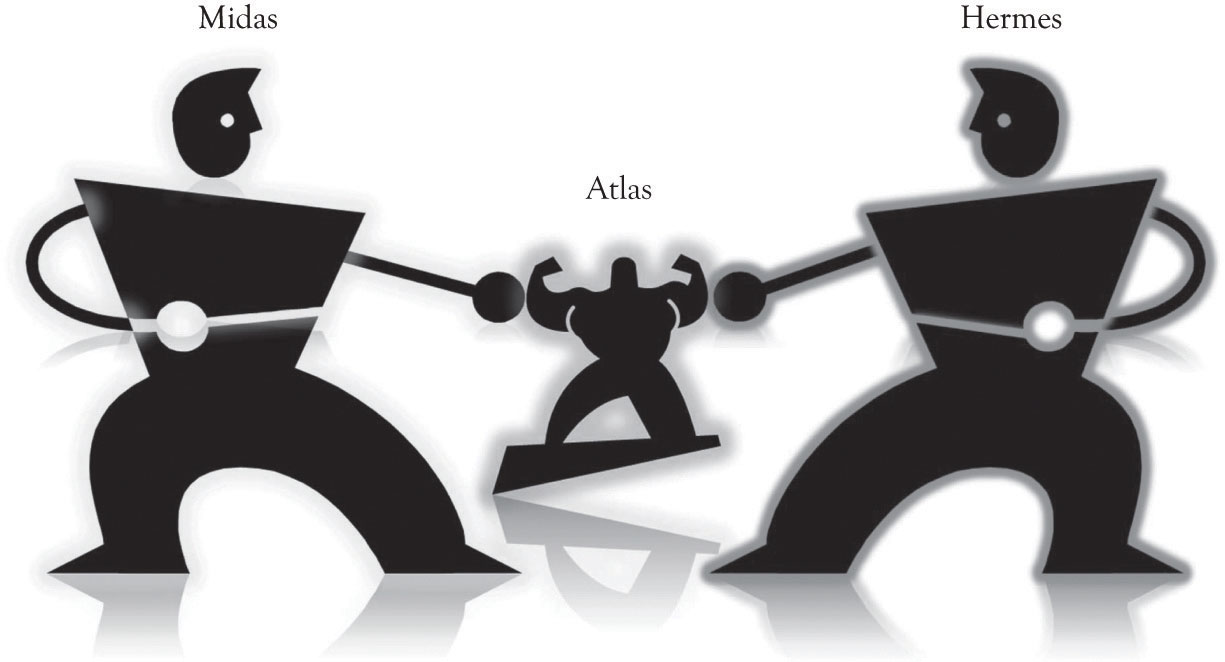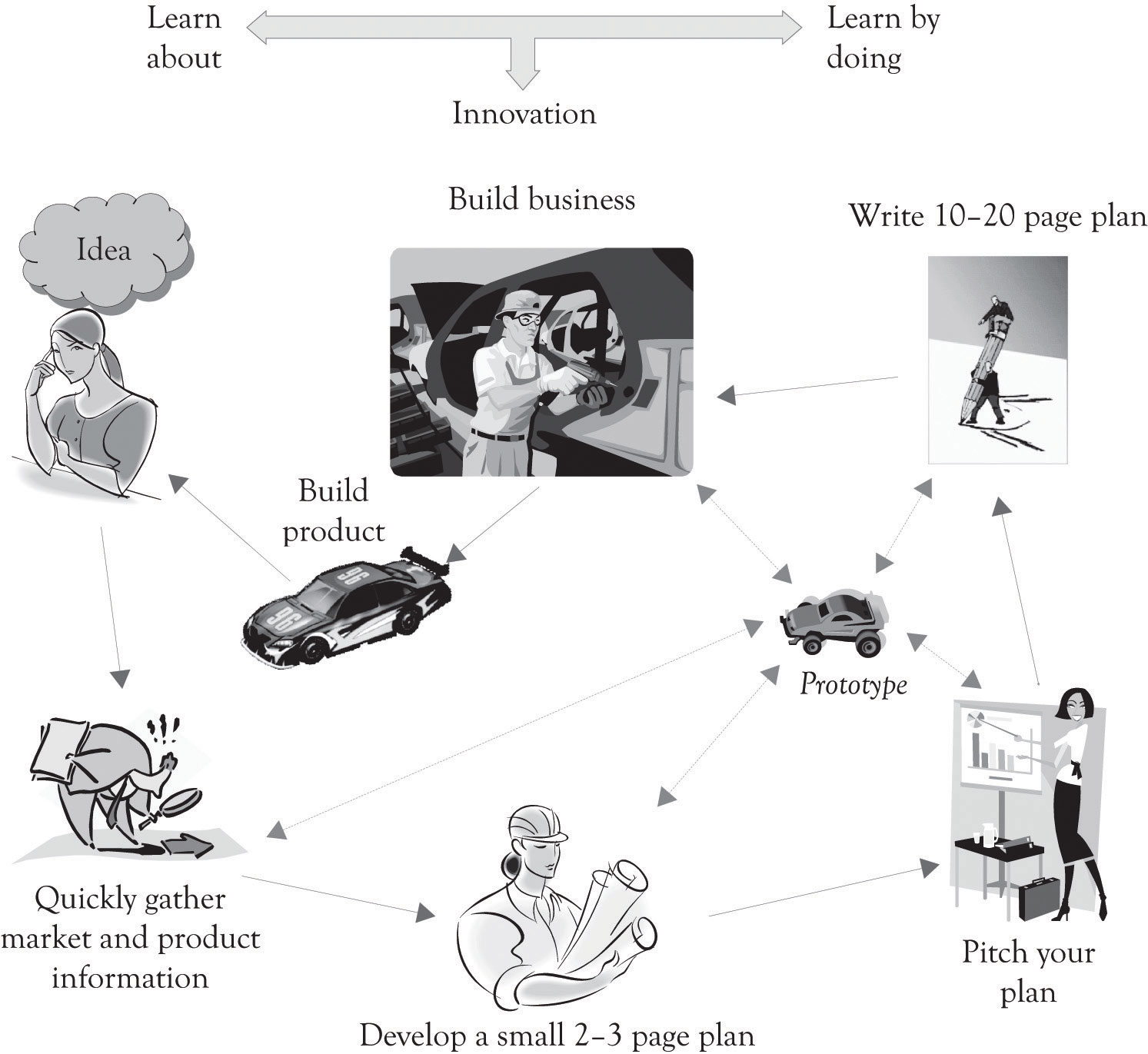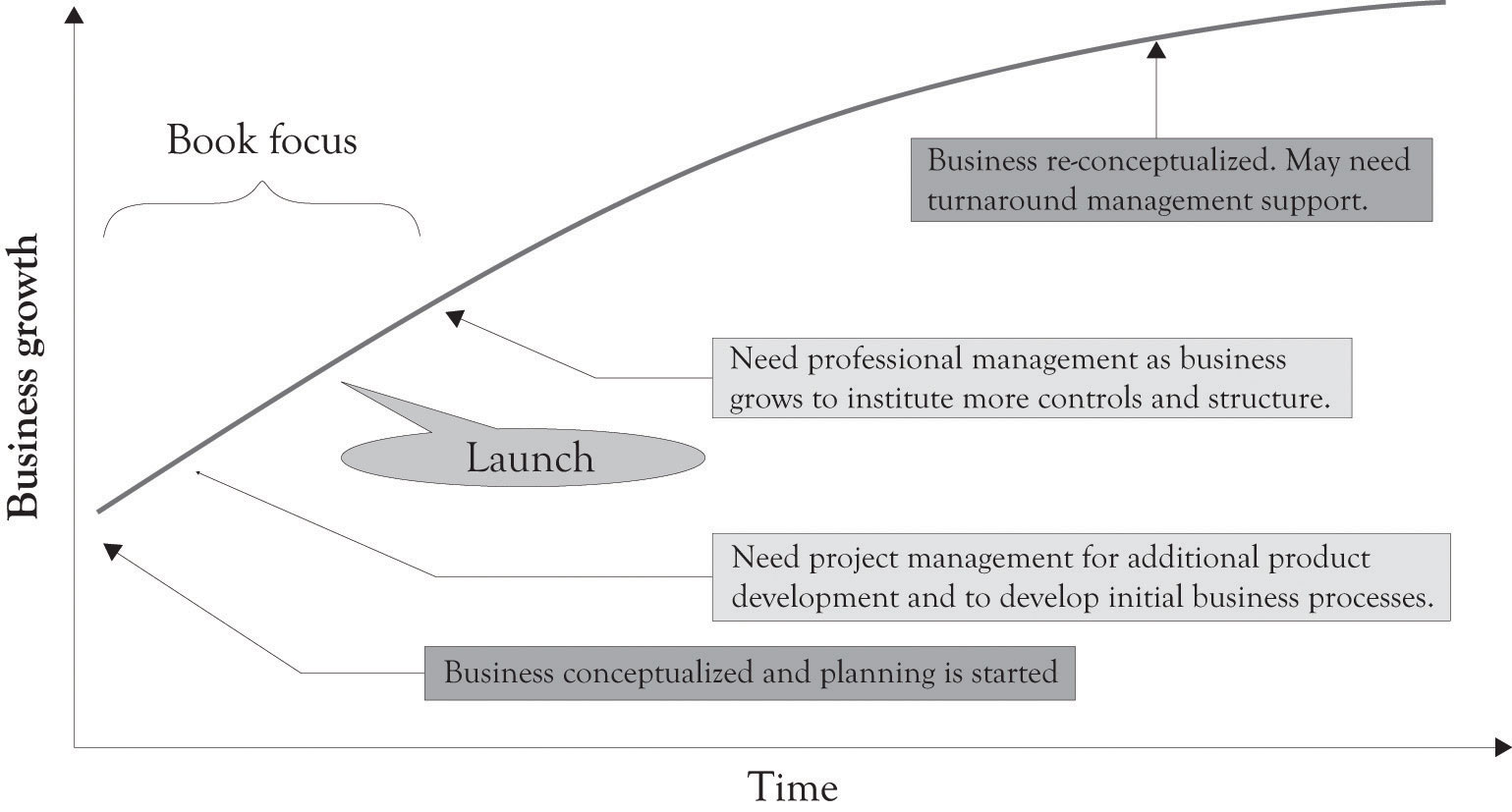This is “Preface”, article 3 from the book Creating Services and Products (v. 1.0). For details on it (including licensing), click here.
For more information on the source of this book, or why it is available for free, please see the project's home page. You can browse or download additional books there. To download a .zip file containing this book to use offline, simply click here.
Preface
A central theme of this book is that there is, or should be, a constant struggle going on in every organization, business, and system. The struggle is fueled by the dynamic tension that exists between delivering Midas feature-rich versions of products and services using extravagant engineering and delivering low-cost Hermes versions of products and services using frugal engineering (see Figure 1). Midas versions are high-end products for nonprice-sensitive consumers. Hermes versions are for price-sensitive consumers. The results of this dynamic tension between Midas versioning and Hermes versioning are Atlas products and services. Atlas products and services are designed for mainstream consumers. Atlas products and services incorporate the product design features that will attract the broadest customer base and will also be profitable. The driving force behind the development of Midas, Atlas, and Hermes versions is driven by the implicit creative genius that everyone possess and most businesses should possess as they engage in continuous learning-about and learn-by-doing activities.
Anyone can learn how to be creative and innovative. Just work hard by learning about the problem, and then try to solve the problem by making or doing something. Not all systems and businesses can be creative and innovative. Some companies can work hard and they can learn about a problem but they cannot build and do things because they have lost the ability to do so. They have lost the ability to learn-by-doing.

The Dueling Mantras
Our primary mantra for a business is “differentiate through innovation or perish.” This is accomplished primarily through extravagant engineering and design and the construction of Midas versions. This is not an easy path to follow, because there is a natural tendency toward inertia and resting on one's laurels.We do not believe that technology and new product development should be pursued with abandon and without analysis. We do believe that bandwagon effects can occur and that unbridled enthusiasm can lead to faulty business models and major mistakes. A sound planning process can alleviate many of these issues. It is our assertion that creative and innovative business planning driven by learning-about and learning-by-doing leads to sustainable businesses. Our focus will be on the upfront activities and ideas for product and service differentiation that result in competitive products and services. They include the endless cycle of business planning, creative and innovative insight, learning-about, and learning-by-doing.
The second mantra of the entrepreneur is to “strive to reduce costs.” This is accomplished primarily through frugal engineering and design and the construction of Hermes versions. Some organizations have been overly enthusiastic in embracing this mantra. In some businesses, learning-by-doing has been abandoned in an attempt to dramatically cut costs and increase margins in the wake of intense international competition. But this has had a negative impact on the ability of many organizations to innovate, because many companies have lost the ability to exploit new knowledge and information when it becomes available. Many organizations have lost what is referred to as absorptive capacity. Absorptive capacity is the ability of a firm to “recognize the value of new information, assimilate it, and apply it to commercial ends.”Cohen and Levinthal (1990), p. 128. It is the ability to apply previously gained knowledge and insight to understanding how new information and knowledge can be applied. Developing absorptive capacity is synonymous with developing insight. Insight is the ability to perceive complex situations, problems and opportunities clearly and deeply. Andy Grove, a past founder and CEO of Intel, pegs the current situation perfectly:
Silicon Valley is a community with a strong tradition of engineering, and engineers are a peculiar breed. They are eager to solve whatever problems they encounter. If profit margins are the problem, we go to work on margins, with exquisite focus. Each company, ruggedly individualistic, does its best to expand efficiently and improve its own profitability. However, our pursuit of our individual businesses, which often involves transferring manufacturing and a great deal of engineering out of the country, has hindered our ability to bring innovations to scale at home. Without scaling, we don't just lose jobs—we lose our hold on new technologies. Losing the ability to scale will ultimately damage our capacity to innovate.Grove (2010).
The USA is losing the ability to compete in high-tech fields in part because it has abandoned learning-by-doing. Basic research and applied research involving broad-based collaboration by government, academia, and business are essential for solving societal problems and in providing a base for technology-based businesses.Pisano and Shih (2009). Basic research involves understating the fundamental principles and dynamics of physics, chemistry, biology, and cybernetics to name a few. Applied research involves translating the principles and dynamics of basic research into commercial applications. The U.S. government up to about 1990 distributed about the same amount of funds to both basic and applied research projects. In recent years, the gap between basic research funding and applied research funding has been widening. The U.S. government has provided less money for applied research.Pisano and Shih (2009).
Outsourcing has also reduced the level of applied research. New product development is essentially applied research. New product development is facilitated when an organization has core competencies in research and development (R&D), product design, and manufacturing. Everyone is beginning to realize that there is a synergistic interplay between R&D, product design, marketing, and manufacturing. New product development is put at risk when these activities are outsourced, off-shored, or both. Entire industries are affected as the knowledge is not readily available for solving problems and realizing new opportunities essentially because it is embedded elsewhere.
Learning-by-Doing as the Basis for Competitiveness and Sustainability
Learning-by-doing means that the organization makes and builds things, conducts experiments, and builds prototypes. This includes the manufacturing process. The loss of absorptive capacity insight can often be traced to outsourcing. Outsourcing typically occurs when products and service margins are under severe market pressure, and organizations are forced to increase productivity by turning to locations where labor costs are substantially lower. This can have serious consequences. If the organization loses its absorptive capacity, then the organization may not be able to understand and recognize when an emerging technology is important. In essence, the organization does not have the ability to acquire know-how, expertise and skills because it has lost the ability to learn-by-doing and learn-about emerging ideas and technologies. Grove's solution to recapturing creative and innovative mojo is to reduce costs by also increasing the scale of operations. The essence of his idea is that if an organization can produce more, it will also be able to take advantage of learning effects and to cover the fixed costs of production. Intel is committed to product differentiation, scale and cost reduction, in-house manufacturing, and in-house design. Long-term sustainability is inextricably linked to the synergistic interplay of design, manufacturing, and market awareness.
There is a revolution taking place in all businesses. Additive and desktop manufacturing, open-source software, and the do-it-yourself movement are fueling this revolution. Products and components can be conceptualized, designed, and built using 3D printers. These printers use a process that is similar to building up layers of plastic and composite materials to build products and parts and to prototype ideas. A do-it-yourselfer can assemble such a printer for under $1,000. A commercial printer can be obtained in the $10–$20K range. The products produced from these printers can be used to produce commercial products and for prototyping. Large-scale 3D printers are being developed to produce products and components the size of aircraft wings. There is also a revolution taking place in the development of services. Cloud computing, applications development tools, and open-source software are having a profound impact on the delivery of software-related services and applications. Software start-ups and prototypes can be constructed without investing in large-scale hardware infrastructure. The software itself can be cobbled together with a variety of development tools and open-source software. Competition can come from any size of company from anywhere in the world. All that is needed is an idea, hard work, and experimentation.
The Big Aha and Learning-by-doing
As we shall see throughout the book, the magic sauce of innovation involves learning and experimentation. Weaving together the little ahas through a continuous learning process is the basis of interesting ideas and innovation. As illustrated in Figure 2, learning-about and learning-by-doing are the drivers of innovation and new product development. This process involves the continuous mixing together of collaboration, searching for ideas, and then making things. As noted in Chapter 6 "Facilitating Creativity and Innovation", the little ahas eventually lead to the big aha and the big aha is not necessarily the solution to the original problem. The big aha is simply illuminating, insightful, and innovative. Peter Sims suggests the placing of little bets to explore possibilities and engage in innovation.Sims (2011). Little bets are essentially low-risk investments with a chance of failure that incorporate the development and testing of ideas. Placing little bets leads to little ahas and eventually to the big aha. Placing little bets are actually investments in what are referred to as real options, and that topic will be covered in depth in Chapter 14 "Re-priming the Business Using Real Options Concepts".

There are of course other important issues in the execution of a successful business, including the development of an efficient supply chain and the development of a strong brand. The supply chain and developing a brand are discussed throughout the book, but they deserve more attention and detail and the reader is encouraged to learn-about these topics by reading and attending professional development programs. As noted in Chapter 8 "Strategic Planning and Ten–Ten Planning", organizations need above-average performance in terms of product and service innovation, the supply chain, and branding in order to survive.
Book Chapters
This book is concerned primarily with the early stages of conceptualizing new ideas that can enhance existing business models and subsequently lead to the creation of new businesses (see Figure 3). The material in this book has been in development over the last 10 years in a course on technology management and development. One purpose of the course is to understand how technologies unfold and how they guide the strategic direction of contemporary business. The course involves reading and discussing over a dozen cases a wide variety of successful, emerging, and unsuccessful businesses. The cases used in the course are usually matched to chapter topics. The case studies and class dialog coupled with the reading of the book chapters are part of the learning-about process. The learn-by-doing part of the course involves the development of a business plan for a start-up company.

- Chapter 1 "Concepts in the Context of Monopolistic Competition" introduces the fundamental concepts related to understanding innovation, diffusion, technology life cycles, R&D, and entrepreneurship within the context of monopolistic competition. The importance of learning-about and learning-by-doing for developing innovative products and services is discussed.
- Chapter 2 "Fundamentals of Product and Price Differentiation" illustrates the importance of product and price differentiation and how they relate to a consumer's willingness-to-pay and to price sensitivities. The chapter also describes first-, second-, and third-degree price discrimination strategies and how they can be implemented.
- Chapter 3 "Differentiation in Action" illustrates why product differentiation and price discrimination can generate additional revenues. The chapter focuses on the use of versioning to aid in product differentiation. A spreadsheet is dashboard presented that can be used to assist in product versioning. The importance of complementary and substitute goods and their impact on revenues is also examined.
- Chapter 4 "Dynamic Tension in Versioning and PD Curves" illustrates a model for constructing product differentiation curves that draws on the dynamic tension that exists between developing high-end Midas products and low-end Hermes products. The results of this dynamic tension between Midas versioning and Hermes versioning are Atlas products and services. Atlas products and services are designed for mainstream consumers.
- Chapter 5 "Examples of Product Differentiation & Versioning Curves" shows a variety of product differentiation and versioning strategies that have been used by businesses. Some businesses focus on versioning at the high end, some businesses focus on price-sensitive consumers, and some businesses try to offer products across the entire demand curve.
- Chapter 6 "Facilitating Creativity and Innovation" discusses the concepts of creativity and innovation. Fostering creativity and innovative activity can be accomplished by dialog and discussion, learning-about, encouragement, time, solitude, experimentation, construction, and by having a supportive environment.
- Chapter 7 "Conceptualizing Products/Services Using FAD" introduces the FAD (features, attributes, and design) template. The FAD template is used to identify the features and attributes that can be used for product and service differentiation. The FAD template incorporates concepts from meaning-driven design (MDD), user-driven design (UDD), and technology-driven design (TDD) and also uses a classification scheme that can be used to ascertain whether attributes and features are increasing or declining in importance.
- Chapter 8 "Strategic Planning and Ten–Ten Planning" presents a brief overview of the more popular approaches for strategic planning. This chapter also sets the stage for the Ten–Ten planning process, a simplified yet robust approach to planning that will be detailed in Chapter 9 "The Ten–Ten Planning Process: Crafting a Business Story".
- Chapter 9 "The Ten–Ten Planning Process: Crafting a Business Story" details the Ten–Ten planning process. The Ten–Ten planning process contains two templates: an Organizational and Industry Analysis template and the Business Plan Overview template. The idea behind the Ten–Ten approach is that once you have gathered some background data related to the industry and the organization, you should be able to complete the two very quickly. The chapter also describes how the Business Plan Overview template and the Industry and Organizational template in conjunction with the FAD template can be used to develop an executive summary for the business plan.
- Chapter 10 "Lock-In and Revenue Growth" discusses the importance of lock-in from the producer's perspective in achieving revenue goals through network effects. The chapter also highlights how buyers try to avoid lock-in in order to maintain flexibility and avoid switching costs.
- The entrepreneur, the entrepreneur's friends and family, investors, and banks are interested in how much a business is worth. Chapter 11 "Valuing the Business" discusses several approaches for valuing a business and presents several examples of how they can be applied.
- Chapter 12 "Developing a Business Plan" presents a detailed approach for constructing a business plan. The expanded business plan provides additional focus by adding details on the what, why, how, when, and for whom a product or service will be produced. The FAD template, the Organizational and Industry Analysis template, the Business Plan Overview template and the executive summary are used as the basis for developing a full-scale business plan. A variety of issues are also discussed including the plan format, the writing style, investors, and legal issues. This chapter also discusses how to pitch the plan to interested parties.
- Chapter 13 "Project Management for New Products and Services" presents an overview of the essential tools and techniques for project management. Once the initial business model has been created, the hard work begins. In most situations, everything is new and needs to be built up from scratch. The entire supply chain has to be built and tested to insure that orders for products and services can be accepted, filled, and supported. Project management is a critical tool in the never-ending process of business growth and renewal. It allows the entrepreneur to minimize and mitigate inherent risks and increase the potential for the successful launch of the enterprise and the ensuing business renewal.
- Chapter 14 "Re-priming the Business Using Real Options Concepts" is about business renewal. It does not matter how innovative or how much money the current business is making. There is a life cycle for products and technologies, and eventually the business will decline unless it can find new opportunities. This chapter focuses on how real options concepts can be used as the foundation for continually reinventing the business.
- Chapter 15 "Wrap-Up" discusses the importance of being entrepreneurial in renewal. If a business does not make little and big tweaks to products and services, it will become a business footnote. The ideas presented in this book will not guarantee success, but they can be used to confront and also to ignore the competition by identifying and creating opportunities that supersede the competition.




